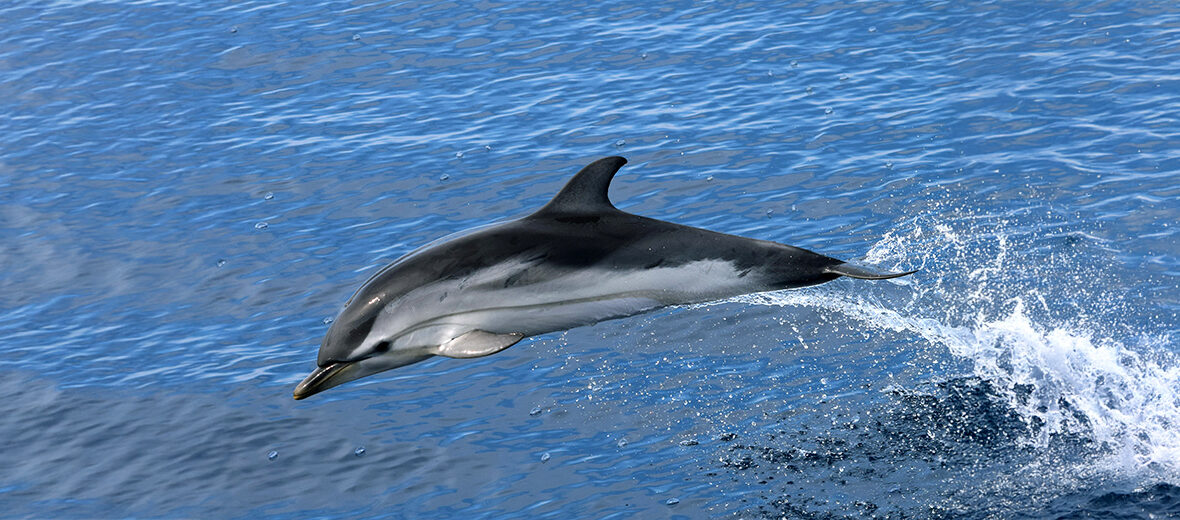
The striped dolphin, aka euphrosyne dolphin or streaker, is found globally in tropical and temperate waters. These dolphins are included in the genus Stenella; however, recent genetic work by LeDuc et al. in 1999 indicated that Stenella is not a natural group. They face the usual oceanic threats of overfishing; bycatch (being caught in fishing nets and long lines); and pollution, including agricultural, military effluents, & urban waste (like plastics). However, these dolphins are considered abundant enough to be listed as Least Concern by the IUCN. Their population trend is unknown at this point.
First the Stats…
Scientific name: Stenella coeruleoalba
Weight: Up to 350 lbs.
Length: Up to 8.5 feet
Lifespan: Up to 58 years
Now on to the Facts!
1.) The closest relatives of striped dolphins are the the common dolphins, Clymene dolphins, Atlantic spotted dolphins, and Indo-Pacific bottlenose dolphins.
2.) They were originally described by Russian physicist & botanist Franz Meyen in 1833.
3.) Even though their coloring is noticeably different, these dolphins have the typical dolphin size and shape as many other globally distributed dolphins.
4.) Such is the case with many dolphins, these critters can be seen in massive pods numbering up to thousands of individuals!
5.) In the Atlantic and Mediterranean these dolphins are known to approach boats to investigate and to ride the wakes of moving boats. However, in the Pacific, where they are heavily exploited, they typically avoid boats.
But wait, there’s more on the striped dolphin!
6.) Japanese whalers have traditionally hunted striped dolphins in the western Pacific since about the 1940s. In the boom of “striped dolphin drives”, at least 8,000 – 9,000 individuals were killed each year, and in 1 particular year, 21,000 individuals were sadly killed!
7.) Since the 1980s, following the introduction of whaling and fishing quotas, this number has continued to be reduced, with about 200 striped dolphins hunted annually in the 2020s. A nice decline from the numbers of the 20th century.
Did you know…?
There is recent concern about the Mediterranean population being threatened by busy shipping lanes, disease, heavy incidental catches, pollution, military sonar, and chemical pollution from near by harbors.
8.) Females undergo up to a 12 month gestation (pregnancy) every 3 – 4 years, that yields a single calf.
9.) Calves measure up to 3 feet long and weigh up to 22 lbs.
10.) All attempts to keep the striped dolphin in captivity have failed, sans a few captured in Japan for the Taiji Whale Museum.
But wait, there’s still more on the striped dolphin!
11.) Fish, squid, octopus, krill, and other crustaceans are all preyed on, with cephalopods comprising up to 50% – 100% of their diet. Northeastern Atlantic striped dolphins most often prey on fish, frequently cod.
12.) These dolphins can dive to depths of up to 2,297 feet!
Did you know…?
With a grim conservation status and the increasing amount of debris piling up in the ocean every year, striped dolphin’s populations are decreasing. 37 dolphins stranded off the Spanish Mediterranean coast all suffered from dolphin morbillivirus, aka DVM (Morbillivirus is associated with viruses such as measles in humans and canine distemper).
13.) Striped dolphins enjoy breaching the water frequently and are capable of rather high jumps from the water.
14.) Even though the IUCN Red List classifies the striped dolphin as Least Concern, there has still been a 30% reduction in their subpopulation over the last 3 generations.
15.) These dolphins are possibly an indicator species for long-term monitoring of heavy metal accumulation in ocean environments due to their importance in the Japan pelagic food web as well as their ability to live for nearly 60 years.
Now a Short Striped Dolphin Video!
Be sure to share & comment below! Also, check out the Critter Science YouTube channel. Videos added regularly!
Want to suggest a critter for me to write about? Let me know here.
Some source material acquired from: Wikipedia & IUCN
Photo credit: Wanax01




